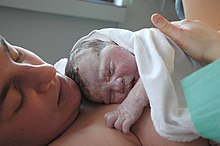
Back مولود حي (إنسان) Arabic Lebendgeburt German Nacimiento vivo Spanish Elussünd Estonian Kelahiran hidup ID Ọmụmụ dị ndụ (mmadụ) IG زندہ زچگی (انسان) Urdu

In human reproduction, a live birth occurs when a fetus exits the mother showing any definite sign of life such as voluntary movement, heartbeat, or pulsation of the umbilical cord, for however brief a time and regardless of whether the umbilical cord or placenta are intact.[1] After the fetus is expelled from the maternal body it is called a neonate. Whether the birth is vaginal or by caesarean section, and whether the neonate is ultimately viable, is irrelevant.
The definition of the term "live birth" was created by the World Health Organization in 1950, and is chiefly used for public health and statistical purposes. However, the term "live birth" was in common use long before 1950.[2]
In the United States, the term "born alive" is defined by federal law[3] known as the born alive rule. Live births are recorded on a U.S. Standard Certificate of Live Birth, also known as a birth certificate.[4] The United States recorded 3,605,201 live births in 2020 which is a 4% decrease from 2019 and the 6th consecutive year of decline in births.[5]
Not all pregnancies result in live births. A woman may choose to end her pregnancy by abortion. Miscarriage, also known as spontaneous abortion and pregnancy loss, is the natural death of an embryo or fetus before it is able to survive independently.[6][7] Some use the cutoff of 20 weeks of gestation, after which fetal death is known as a stillbirth.[8] The death of the fetus or neonate at the end of the pregnancy, during labour and delivery, or just after birth is counted as perinatal mortality.
- ^ World Health Organization. International statistical classification of diseases and related health problems. Tenth Revision. Vol 2. Geneva, Switzerland: World Health Organization, 1993:129.
- ^ Search full view Google Books for "live birth" prior to the year 1950.
- ^ "1 U.S. Code § 8 - "Person", "human being", "child", and "individual" as including born-alive infant". LII / Legal Information Institute. Retrieved 22 August 2017.
- ^ "NVSS - Revisions of the U.S. Standard Certificates and Reports". www.cdc.gov. 2017-08-30. Retrieved 2018-10-23.
- ^ Hamilton, Brady; Martin, Joyce; Osterman, Michelle (May 2021). "Births: Provisional Data for 2020" (PDF). Division of Vital Statistics, National Center for Health Statistics. Vital Statistics Rapid Release. Report No. 012. National Vital Statistics System – via CDC.
- ^ The Johns Hopkins Manual of Gynecology and Obstetrics (4 ed.). Lippincott Williams & Wilkins. 2012. pp. 438–439. ISBN 9781451148015. Archived from the original on September 10, 2017.
- ^ "What is pregnancy loss/miscarriage?". www.nichd.nih.gov/. July 15, 2013. Archived from the original on April 2, 2015. Retrieved March 14, 2015.
- ^ "Stillbirth: Overview". NICHD. September 23, 2014. Archived from the original on October 5, 2016. Retrieved October 4, 2016.
© MMXXIII Rich X Search. We shall prevail. All rights reserved. Rich X Search